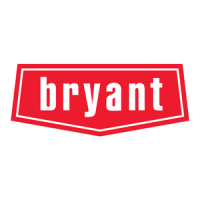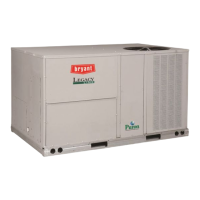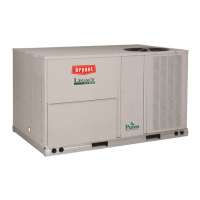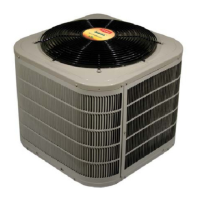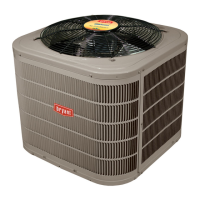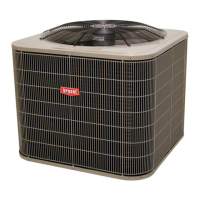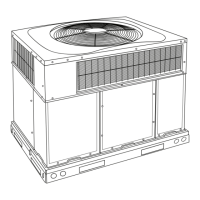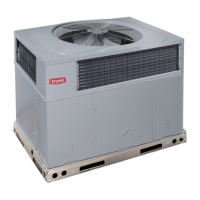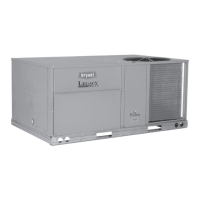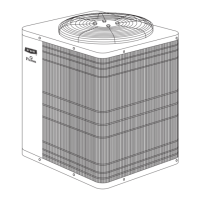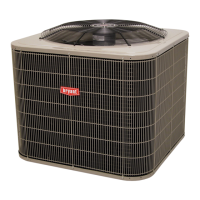2
SAFETY CONSIDERATIONS
Installation and servicing of this equipment can be hazardous due to
mechanical and electrical components. Only trained and qualified
personnel should install, repair, or service this equipment.
Untrained personnel can perform basic maintenance functions such
as cleaning and replacing air filters. All other operations must be
performed by trained service personnel. When working on this
equipment, observe precautions in the literature, on tags, and on la-
bels attached to or shipped with the unit and other safety precautions
that may apply.
Follow all safety codes. Wear safety glasses, protective clothing,
and work gloves. Have fire extinguisher available. Read these in-
structions thoroughly and follow all warnings or cautions included
in literature and attached to the unit. Consult local building codes,
the current editions of the National Fuel Gas Code (NFGC) NFPA
54/ANSI Z223.1, and the National Electrical Code (NEC) NFPA
70.
In Canada refer to the current editions of the National Standards of
Canada CAN/CSA--B149.1 and .2 Natural Gasand Propane Install-
ation codes, and Canadian Electrical Code CSA C22.1.
Recognize safety information. This is the safety-- alert symbol
!
!
When you seethissymbolon theunitand ininstructions or manuals,
be alert to the potential for personal injury.
Understand these signal words; DANGER, WARNING, and CAU-
TION. These words are used with the safety-- alert symbol. DAN-
GER identifies the most serious hazards which will result in severe
personal injury or death. WARNING signifies hazards which could
result in personal injury or death. CAUTION is used to identify un-
safe practices which may result in minor personal injury or product
and property damage. NOTE is used to highlight suggestions which
will result in enhanced installation, reliability , or operation.
Note: Installer: This manual should beleft with the equipment user.
FIRE,EXPLOSION,ELECTRICAL SHOCK HAZARD
Failure to follow this warning could result in personal injury,
death or property damage.
Installation and servicing of this equipment can be hazardous
due to mechanical and electrical components. Only trained
and qualified personnel should install repair or service this
equipment.
!
WARNING
FIRE,EXPLOSION,ELECTRICAL SHOCK HAZARD
Failure to follow this warning could result in personal injury,
death or property damage.
Do not use this unit if any part has been under water.
Immediately call a qualified service technician to inspect the
unit and to replace any part of the control system which has
been under water.
!
WARNING
CUT HAZARD
Failure to follow this caution may result in personal injury.
When removing access panels or performing maintenance
functions inside your unit, be aware of sharp sheet metal parts
and screws. Although special care is taken to reduce sharp
edges to a minimum, be extremely careful when handling
parts or reaching into the unit.
!
CAUTION
FIRE AND EXPLOSION HAZARD
What to do if you smell gas:
1. Do not try to light any appliance.
2. Do not touch any electrical switch; do not use any phone in
your building.
3. Leave the building immediately.
4. Immediately call your gas supplier from a nearby phone.
Follow the gas supplier’s instructions.
5. If you cannot reach your gas supplier, call the fire
department.
!
WARNING
ELECTRICAL SHOCK HAZARD
Failure to follow this warning could result in personal injury
and/or death.
Before performing recommended maintenance, be sure the
main power switch to unit is turned off and lock -- out tag is
installed.
!
WARNING
FIRE,EXPLOSION,ELECTRICAL SHOCK HAZARD
Failure to follow this hazard warning could result in personal
injury, death and/or property damage.
1. Do not turn off the electrical power to unit without first
turning off the gas supply.
2. Before attempting to start the gas heating section,
familiarize yourself with all the procedures that must be
followed.
!
WARNING
FIRE, EXPLOSION HAZARD
Failure to follow this warning could result in personal injury,
death, and/or property damage.
Do not attempt to light by hand.
!
WARNING

